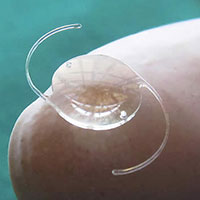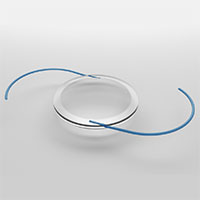Home / Our Services /
Cataract Surgery
Cataracts are one of the leading causes of vision impairment in the United States. A natural part of aging, a cataract is a clouding of the lens inside your eye. If you are over 55, there’s a good chance that you may have some form of cataracts. Because they form slowly over a long period of time, many people suffer from this condition without ever realizing it.
When the lens becomes clouded with a cataract, it prevents lights and images from reaching the retina. Vision with cataracts has been described as seeing through a cloudy or foggy window. If you experience any of these symptoms, you may have cataracts:
- Blurry or foggy vision
- Colors appear dull, washed out or faded
- Poor night vision
- Halos appear around lights
- Sensitivity to sunlight or bright lights
- Needing more light to read
- Your glasses don’t seem to work
If left untreated, the clouded areas of your lens will become larger and denser, causing your sight to become worse. This may take months or many years. Eventually, though, your entire lens will cloud and can cause blindness. More than three million cataract procedures are performed each year in the United States alone.
If you think that you may have cataracts, contact our office to schedule an evaluation.
Take our cataract self test
Treating Your Cataracts
The only way to truly correct your vision is to remove your clouded lens and replace it with a new, artificial one. It’s a safe, simple procedure that can be performed as soon as your vision interferes with your daily life. Today, patients can choose from a variety of replacement lenses (IOL-intraocular lens), there are several different techniques to surgically remove cataracts. The two main cataracts surgeries are termed traditional and laser-assisted. Laser-assisted cataract surgery treats astigmatism as well as breaking up and softening the hard cataract nucleus for safe removal through a microincision. By treating astigmatism, better vision can be achieved. Dr. Haverly prefers the laser-assisted technique for these reasons.
When preparing for your traditional or laser cataract procedure, remember the following:
- You will need someone to drive you to and from the surgery center. No overnight stay is required and the whole process usually lasts less than 30 minutes.
- Before and/or after surgery, your doctor will likely prescribe eye drops to help prevent infection and reduce swelling for faster recovery.
- Most patients experience improved vision very soon after surgery. Larger and more dense cataracts will take longer for your vision to improve.
- One eye is treated at a time to give the eye adequate time to recover and stabilize before treating the other. This usually takes several weeks.
Following your procedure, your brain will have to learn how to work with your new artificial lens. It may take a few weeks or even months for your vision to be optimal.
Talk to our doctors about the risks and benefits of cataract procedures so you can make an informed decision about your options.
Which Replacement Lens is Right for Me?
Because of the options available, there has never been a better time to have cataract surgery. An intraocular lens, known as an IOL, is an artificial lens used to replace your cloudy natural lens. Today’s options with IOLs offer an opportunity to correct other vision problems. Because no single lens is right for everyone, our doctors will determine which lens is the most appropriate option for you.

Monofocal Lenses
These lenses have a single focal point for clear distance vision. While distance vision is improved, most patients still need to wear glasses for near vision activities, examples including using the computer, reading, and putting on makeup.

Astigmatism Correcting Lenses
These lenses are designed to provide a full range of clear, sharp vision, but some patients may still need glasses for certain activities.

Multifocal Lenses
These lenses are designed to provide focus for both distance and near objects. They can correct for nearsightedness, farsightedness and presbyopia.
Laser eye surgery of erie
Cataract Surgery Options
During cataract surgery, the natural lens of your eye is removed and replaced with a clear artificial lens called an intraocular lens implant. There are two approaches – traditional and advanced laser assisted.
Laser-Assisted Cataract Surgery using the ALCON LenSx® Laser Technology
What is the LenSx Laser?
The LenSx® Laser is one of the most advanced and safest ways to perform cataract surgery. The LenSx® Laser is an advanced, precision based technology that operates with unmatched precision and computer-control, helping Dr. Haverly to customize the procedure to your eye. The LenSx® laser is designed to treat astigmatism and breakup and soften the cataract for safe removal.
A Custom Tailored Astigmatism Treatment for Your Eyes
While all human eyes share the same basic anatomical structure, every eye is different in terms of size, depth, curvature of the cornea and other key features. This is why every eye must be carefully measured and mapped prior to cataract surgery. While these measurements have been routinely performed prior to surgery, the LenSx® Laser uses a range of highly advanced technologies- including integrated optical coherence tomography (OCT)- to capture incredible precise, high-resolution images of your eyes. These images- and the measurements and data they provide- are then used to plan and perform a surgery to exacting specifications not attainable with traditional surgery.
Computer Control to Ensure Unmatched Precision and Accuracy Every Step of the Way
The LenSx® Laser adds computer-control to key steps of cataract surgery. Its unique software control system analyzes high-resolution OCT images of your eye. This helps Dr. Haverly design a customized procedure, and then, perform the procedure on command! To further enhance the accuracy, a patient interface connects your eye to the image-guided surgical unit. This allows Dr. Haverly to have precise, real-time images at all times during the laser procedure.
The Next Evolution in Cataract Surgery
In non-laser cataract surgery, the surgeon makes incisions and removes the old lens using traditional surgical instruments and blades. The LenSx® Laser performs several of the most critical steps of the surgical process with an image-guided femtosecond laser. The LenSx® Laser is an ophthalmic laser for use in patients undergoing cataract surgery. The laser is used as a tool to fragment a cataractous lens, to create a capsular opening and to treat astigmatism. The LenSx® Laser uses an accessory called the LenSx® Laser Patient Interface to hold the eye steady during the procedure.
https://www.myalcon.com/professional/cataract-surgery/surgical-equipment/lensx-laser-system/
Traditional Surgery
The traditional surgical process involves a small incision phacoemulsification technique which many eye doctors refer to as micro-surgery. This means that the cataract surgery is performed using the smallest possible incision and removal of the lens material is accomplished using an ultrasonic needle. Once the eye has been properly dilated, the eye is then prepared with a cleaning solution. Topical anesthetic is then administered to the surface of the eye. Next, under a microscope, an incision of less than 3 millimeters in length is created at the junction of the cornea (the clear structure on the front of the eye) and the sclera (the white part of the eye).
After the incision is made, another dose of anesthetic is administered inside the eye. The front part of the lens envelope, known as the lens capsule, is carefully opened so that the lens material can be removed. This is accomplished using a needle-like ultrasonic device, which pulverizes the hardened and yellowed lens proteins known as the cataract. The pulverized material is simultaneously vacuumed from the eye. Once the cataract material has been removed, a foldable (IOL) intraocular lens is inserted through the main incision and positioned into the lens capsule. The lens will remain inside your eye in this location without moving. Intraocular lenses cannot be felt or sensed in any way by the patient. There are different options for the replacement lens that may enable vision without glasses after surgery.
Treating Your Cataract and Glaucoma Together
Microinvasive glaucoma surgery (MIGS) has emerged as an integral and increasingly common approach in conjunction with cataract surgery for patients with glaucoma. MIGS encompasses a range of surgical techniques that aim to address the underlying mechanisms of glaucoma while minimizing invasiveness and optimizing patient outcomes. Among the various types of MIGS procedures, goniotomies and iStents have gained widespread acceptance and are frequently employed.
A goniotomy procedure involves the delicate surgical opening of the trabecular meshwork, which is responsible for facilitating the drainage of aqueous humor from the eye. This surgical intervention enhances the outflow of aqueous humor, reducing intraocular pressure and thus managing glaucoma. Similarly, iStents function as micro-sized stents implanted within the trabecular meshwork to enhance the drainage pathway. These stents provide a sustained increase in outflow and can be used in combination with cataract surgery to effectively control intraocular pressure.
MIGS procedures like goniotomies and iStents draw inspiration from the concept of stents employed in cardiovascular medicine. In the context of heart attacks and strokes, stents are used to restore blood flow by unblocking clogged blood vessels. Similarly, goniotomies and iStents work towards removing obstructions and facilitating the efficient drainage of aqueous humor, thereby reducing intraocular pressure and alleviating the impact of glaucoma.
American Academy of Ophthalmology information:
https://www.aao.org/practice-management/news-detail/goniotomy-cataract-surgery
https://www.aao.org/eye-health/treatments/combined-cataract-glaucoma-surgery-facts

